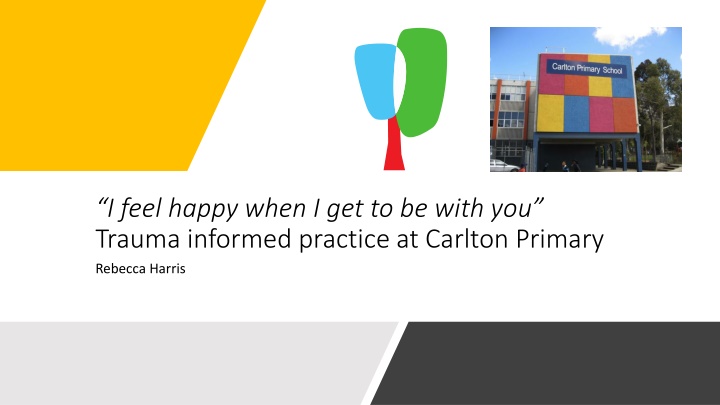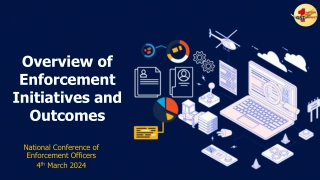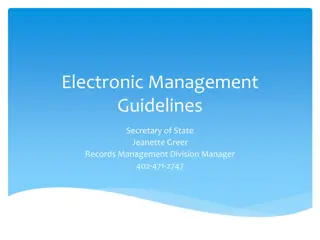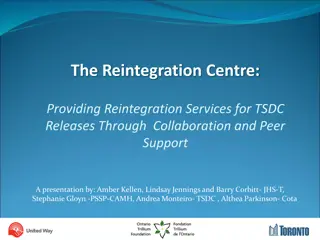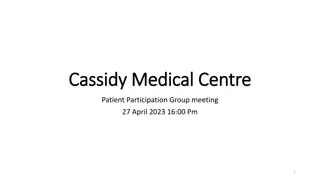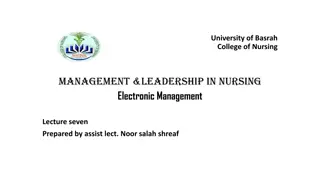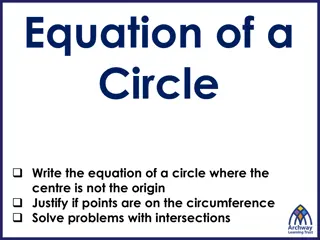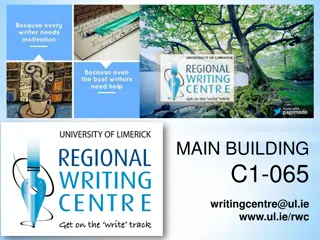CzechELib: National Centre for Electronic Information Resources
CzechELib, managed by the Czech National Library of Technology and Ministry of Education, Youth, and Sports, aims to reduce public spending on administrative activities related to electronic information resources. It represents major users in the Czech Republic and covers a range of EIR, negotiating license agreements and providing support for research organizations. The project's operational program spans from 2017 to 2022, with total costs amounting to 1.3 billion CZK.
Download Presentation

Please find below an Image/Link to download the presentation.
The content on the website is provided AS IS for your information and personal use only. It may not be sold, licensed, or shared on other websites without obtaining consent from the author.If you encounter any issues during the download, it is possible that the publisher has removed the file from their server.
You are allowed to download the files provided on this website for personal or commercial use, subject to the condition that they are used lawfully. All files are the property of their respective owners.
The content on the website is provided AS IS for your information and personal use only. It may not be sold, licensed, or shared on other websites without obtaining consent from the author.
E N D
Presentation Transcript
I feel happy when I get to be with you Trauma informed practice at Carlton Primary Rebecca Harris
Two very good reasons to be trauma informed in education It is statistically unlikely that any classroom in the world would have all its students free from childhood trauma; Trauma informed practice is good for all students.
Neuroscience We tried things, they worked, we continued
Neuroscience We tried things, they worked, we continued Neuroscience helped us realise why these things were working
Neuroscience We tried things, they worked, we continued Neuroscience helped us realise why these things were working We began to research, and discovered the clear links between early trauma, brain development, and physical development, with impacts lasting all the way through a lifetime
Neuroscience We tried things, they worked, we continued Neuroscience helped us realise why these things were working We began to research, and discovered the clear links between early trauma, brain development, and physical development, with impacts lasting all the way through a lifetime Repetition is an important factor
Neuroscience We tried things, they worked, we continued Neuroscience helped us realise why these things were working We began to research, and discovered the clear links between early trauma, brain development, and physical development, with impacts lasting all the way through a lifetime Repetition is an important factor Seeking help and not finding it becomes an additional trauma
Neuroscience Everything we learned helped us to realise the power we have as a school
The brain: built for survival "The most important job of the brain is to ensure survival, even under the most miserable conditions" (van der Kolk, 2016)
The brain: built for survival The brain has a very specific response to threat
The brain: built for survival The brain has a very specific response to threat Response to stress caused by interaction with another tends to lead us to make use of social engagement as a strategy to return to equilibrium
The brain: built for survival The brain has a very specific response to threat Response to stress caused by interaction with another tends to lead us to make use of social engagement as a strategy to return to equilibrium If this fails, or for greater levels of threat the Autonomic Nervous System jumps in
The brain: built for survival The brain has a very specific response to threat Response to stress caused by interaction with another tends to lead us to make use of social engagement as a strategy to return to equilibrium If this fails, or for greater levels of threat the Autonomic Nervous System jumps in With Fight/Flight/Active Freeze (sympathetic nervous system)
The brain: built for survival The brain has a very specific response to threat Response to stress caused by interaction with another tends to lead us to make use of social engagement as a strategy to return to equilibrium If this fails, or for greater levels of threat the Autonomic Nervous System jumps in With Fight/Flight/Active Freeze (sympathetic nervous system) Or Fein Death/Freeze (parasympathetic nervous system)
The brain: built for survival The brain has a very specific response to threat Response to stress caused by interaction with another tends to lead us to make use of social engagement as a strategy to return to equilibrium If this fails, or for greater levels of threat the Autonomic Nervous System jumps in With Fight/Flight/Active Freeze (sympathetic nervous system) Or Fein Death/Freeze (parasympathetic nervous system) This is beyond our control
"Exposure to events that represent a real or perceived threat to safety elicit subcortical mammalian, or animal defences that are not mediated by the cortex; in fact, they actually disable cortical activity when engaged. These animal defence strategies are adaptive at the moment of immediate threat, but tend to become default behaviours and inflexible action sequences (Ogden, Goldstein, & Fisher, 2013)
Threat on repeat Great, adaptive response in the face of danger or threat
Threat on repeat Great, adaptive response in the face of danger or threat With repetition, becomes a way of being, physiologically
Threat on repeat Great, adaptive response in the face of danger or threat With repetition, becomes a way of being, physiologically Meaning hyper-vigilance, over-used amygdala
Threat on repeat Great, adaptive response in the face of danger or threat With repetition, becomes a way of being, physiologically Meaning hyper-vigilance, over-used amygdala Disengaged cortex, losing problem-solving, broad thinking and connection between thoughts and feelings
Threat on repeat Great, adaptive response in the face of danger or threat With repetition, becomes a way of being, physiologically Meaning hyper-vigilance, over-used amygdala Disengaged cortex, losing problem-solving, broad thinking and connection between thoughts and feelings All change becomes a potential threat
Trauma Definition: an experience that we perceive as so threatening that it overwhelms us and we feel we are unable to cope.
Trauma Definition: an experience that we perceive as so threatening that it overwhelms us and we feel we are unable to cope Not necessarily a single event like an accident
Trauma Definition: an experience that we perceive as so threatening that it overwhelms us and we feel we are unable to cope Not necessarily a single event like an accident Developmental trauma:
Trauma Definition: an experience that we perceive as so threatening that it overwhelms us and we feel we are unable to cope Not necessarily a single event like an accident Developmental trauma: occurs in childhood, and is identified by the significance of this timing, and by the fact of the repetition of the traumatic experiences
Trauma Definition: an experience that we perceive as so threatening that it overwhelms us and we feel we are unable to cope Not necessarily a single event like an accident Developmental trauma: occurs in childhood, and is identified by the significance of this timing, and by the fact of the repetition of the traumatic experiences Relational trauma: the cause of the trauma is a carer
Trauma Definition: an experience that we perceive as so threatening that it overwhelms us and we feel we are unable to cope Not necessarily a single event like an accident Developmental trauma: occurs in childhood, and is identified by the significance of this timing, and by the fact of the repetition of the traumatic experiences Relational trauma: the cause of the trauma is a carer Can include experiences such as neglect, abuse, poverty, family violence, or lack of a healthy connection with a primary attachment figure
Australian Stats 1 in 3 girls, 1 in 6 boys experience childhood sexual assault. (Ronken & Johnston, 2012) Pregnancy is an increased risk period for intimate partner violence, 40% of children have experiences of domestic violence Of women who experience violence, more than half have children in their care (OurWatch) Violent households have a significantly higher proportion of children aged five years and under (Australian Institute of Criminology, 2011) 5 million adults are affected by childhood trauma (Kezelman, Hossack, Stavropolous, Burley. 2015, p. 10) Children under 1 are the most likely to be the subject of a substantiated child protection notification (Australian Institute of Health and Welfare, 2015) 1 in 5 students are starting school "developmentally vulnerable", doubling for Aboriginal and Torres Strait Islander children (Early Learning, Everyone benefits, 2016, p. 9)
Australian Stats The prevalence of traumatic experiences in childhood show that no classroom is likely without trauma. All systems surrounding children, but particularly education, have a profound opportunity to impact them in powerfully positive ways.
Trans generational trauma Being raised by a traumatised person, can in itself be traumatic
Trans generational trauma Being raised by a traumatised person, can in itself be traumatic Children live with their parents survival strategies
Trans generational trauma Being raised by a traumatised person, can in itself be traumatic Children live with their parents survival strategies Attuned parenting can be a challenge for those who have not experienced it themselves
Trans generational trauma Being raised by a traumatised person, can in itself be traumatic Children live with their parents survival strategies Attuned parenting can be a challenge for those who have not experienced it themselves Very relevant for the experience of Indigenous Australians, and those who have had a refugee experience
Trans generational trauma Being raised by a traumatised person, can in itself be traumatic Children live with their parents survival strategies Attuned parenting can be a challenge for those who have not experienced it themselves Very relevant for the experience of Indigenous Australians, and those who have had a refugee experience Judy Atkinson has written and speaks on the topic in an Indigenous Australian context
The Adverse Childhood Experiences study Longitudinal study (Centres for disease control and prevention, 2016)
The Adverse Childhood Experiences study Longitudinal study (Centres for disease control and prevention, 2016) Via a U.S. health fund, participants were largely from 'advantaged' backgrounds we might consider to be advantaged: white, educated, middle-aged people with 'successful' lives
The Adverse Childhood Experiences study Longitudinal study (Centres for disease control and prevention, 2016) Via a U.S. health fund, participants were largely from 'advantaged' backgrounds we might consider to be advantaged: white, educated, middle-aged people with 'successful' lives Questioned for 10 ACEs relating to abuse and neglect; family members drug/alcohol use, mental illness, or incarceration.
The Adverse Childhood Experiences study - Results 64% of people had experienced 1 or more ACEs, and 22% 3 or more
The Adverse Childhood Experiences study - Results 64% of people had experienced 1 or more ACEs, and 22% 3 or more Identified a significant link between the number of ACEs and depression, suicide attempts, alcoholism, drug abuse, sexual promiscuity, domestic violence, cigarette smoking, obesity, physical inactivity, and sexually transmitted diseases. Also an increased chance of developing heart disease, cancer, stroke, diabetes, skeletal fractures, and liver disease.
Memory and Trauma "Trauma dramatically affects children's memory capacity. It serves to degrade children's memories. Children's working memory is extensively reduced. They find it difficult to learn. They are not able to remember events and the sequence in which they occurred. They are unable to build a narrative about their lives which draws out meaning and understanding. In many ways, trauma reduces children's ability to remember who they are." (Australian Childhood Foundation, 2006, p,1).
Memory and Trauma Adaptive practices like dissociation, division of focus, repression of memory, detachment from emotion, are unhelpful when it comes to learning
Memory and Trauma Adaptive practices like dissociation, division of focus, repression of memory, detachment from emotion, are unhelpful when it comes to learning Implicit memory takes over, explicit memories struggle to form
Memory and Trauma Adaptive practices like dissociation, division of focus, repression of memory, detachment from emotion, are unhelpful when it comes to learning Implicit memory takes over, explicit memories struggle to form Vulnerable to triggers
Memory and Trauma Adaptive practices like dissociation, division of focus, repression of memory, detachment from emotion, are unhelpful when it comes to learning Implicit memory takes over, explicit memories struggle to form Vulnerable to triggers Narrative memory, and thus self-narrative can suffer. Important to consider parental self-narrative too.
What we see at school impacts of trauma Relationships and attachment
What we see at school Relationships and attachment Self-regulation and physiological responses
What we see at school Relationships and attachment Self-regulation and physiological responses Cognitive function
What we see at school Relationships and attachment Self-regulation and physiological responses Cognitive function Sense of self
What we see at school Relationships and attachment Self-regulation and physiological responses Cognitive function Sense of self Focus and concentration
A trauma informed school "Traditional explanations of children's disruptive behaviours often emphasis their volitional aspects, suggesting that they occur as a result of bad choices, or intentional defiance ... Recent studies of trauma and self and self-regulation provide an explanation." (Craig, 2016)
